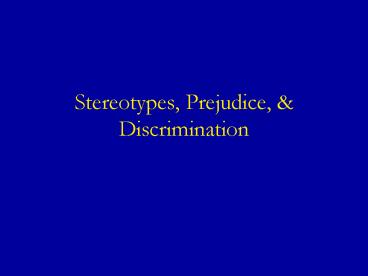Stereotypes, Prejudice, - PowerPoint PPT Presentation
1 / 37
Title:
Stereotypes, Prejudice,
Description:
a set of beliefs about the personal attributes of a group of people (Ashmore & Del Boca, 1981) ... Jigsaw Classroom. 6-person learning groups ... – PowerPoint PPT presentation
Number of Views:244
Avg rating:3.0/5.0
Title: Stereotypes, Prejudice,
1
Stereotypes, Prejudice, Discrimination
2
Stereotypes, Prejudice, Discrimination
- True Colors
- What are your thoughts?
- Does it ring true?
3
Stereotypes, Prejudice, Discrimination
- True Colors
- What are your thoughts?
- Does it ring true?
- Can we use social psychological principles to
understand what happened?
4
Stereotypes, Prejudice, Discrimination
- stereotypes
- a set of beliefs about the personal attributes of
a group of people (Ashmore Del Boca, 1981) - a type of schema
5
Stereotypes, Prejudice, Discrimination
- prejudice
- a biased evaluation of a group (often targeted at
its individual members), based on real or
imagined characteristics of the group members
(Nelson, 2002) - a type of attitude
6
Stereotypes, Prejudice, Discrimination
- discrimination
- negative act towards a person or group of people
because of their group membership
7
Stereotypes, Prejudice, Discrimination
- ABCs of social psychology
- Affect prejudice
- Behavior discrimination
- Cognition stereotypes
8
Stereotypes, Prejudice, Discrimination
- What did we see in True Colors?
- What stereotypes?
- What examples of prejudice?
- What examples of discrimination?
9
Stereotypes
- How stereotypes are formed?
- categorization
10
Stereotypes
- How stereotypes are formed?
- categorization
- ingroups and outgroups (Social Identity Theory
Tajfel Turner, 1986) - ingroup bias (Ostrom Sedikides, 1992)
- outgroup homogeneity bias (Hamilton, 1976)
11
Stereotypes
- How stereotypes are formed?
- categorization
- ingroups and outgroups
- social learning
12
Stereotypes
- stereotypes make information processing more
efficient - name and 10 personality characteristics
- Nigel caring, honest, reliable, friendly
- stereotype Nigel is a doctor
- cognitive load task
- recall characteristics and facts about Indonesia
(Macrae, Milne, Bodenhausen, 1994)
13
Stereotypes
(Macrae, Milne, Bodenhausen, 1994)
14
Stereotypes
- Why do stereotypes persist?
- subcategorization
15
Stereotypes
- Why do stereotypes persist?
- subcategorization
- illusory correlations
16
Stereotypes
- Why do stereotypes persist?
- subcategorization
- illusory correlations
- selective attention to stereotype-relevant
information
17
Stereotypes
- Why do stereotypes persist?
- subcategorization
- illusory correlations
- selective attention to stereotype-relevant
information - once formed, very difficult to change
18
Stereotypes
- stereotype threat
- African American and White participants
- difficult verbal task
- IV intellectual ability (threat) or verbal task
(no threat) - DV performance on the verbal task
(Steele Aronson, 1995)
19
Stereotypes
- stereotype threat
- no threat condition AA and White participants
performed equally - threat condition AA performed more poorly than
the White participants - also shown to occur when race is made salient
(Steele Aronson, 1995)
20
Prejudice
- Where does prejudice come from?
- What can be done about it?
21
Origins of Prejudice
- cultural/group norms
- conformity to the group norm can influence
prejudice
22
Origins of Prejudice
- social dynamics
- Realistic Group Conflict Theory (Levine
Campbell, 1972)
23
Origins of Prejudice
- social dynamics
- Realistic Group Conflict Theory (Levine
Campbell, 1972) - Scapegoat Theory
24
Origins of Prejudice
- social dynamics
- Realistic Group Conflict Theory (Levine
Campbell, 1972) - Scapegoat Theory
- Just World Theory
25
Origins of Prejudice
- universal cognitive processes
- e.g., minimal group paradigm
26
What Can Be Done about Prejudice?
- stereotype suppression
- 5 minutes writing about a skinhead
- IV suppress negative thoughts or not
- 5 minutes writing about the second skinhead
- DV How stereotypic is the writing?
(Macrae, Milne, Bodenhausen, 1994)
27
What Can Be Done about Prejudice?
- stereotype suppression
- suppression condition less stereotypic thinking
the first time, but more stereotypic thinking the
second time
(Macrae, Milne, Bodenhausen, 1994)
28
What Can Be Done about Prejudice?
- contact hypothesis
- increasing exposure to members of outgroups can
increase positive evaluations of the outgroup and
decrease prejudice and stereotyping - e.g., Sherifs Robbers Cave studies
29
What Can Be Done about Prejudice?
- contact hypothesis
- Allport (1954) the effect of contact will
depend on the kind of association that occurs,
and on the kinds of persons who are involved.
30
What Can Be Done about Prejudice?
- contact hypothesis
- four necessary criteria
- equal status members
- common goals
- intergroup cooperation
- support of a legitimate authority (e.g., social
norms)
(Allport, 1954)
31
What Can Be Done about Prejudice?
- contact hypothesis
- an additional criterion
- must be friendship potential
(Pettigrew, 1998)
32
What Can Be Done about Prejudice?
- Jigsaw Classroom
- 6-person learning groups
- each responsible for teaching and learning the
material - pay more attention to and respect each other more
(Aronson, 1979)
33
Discrimination
- difficult to demonstrate at the individual level
- women tend to acknowledge having been
discriminated against as a group, but few report
being personally being discriminated against
(Crosby, 1981)
34
Discrimination
- normally assessed at the aggregate level
- Florida homicide cases 1976-77
- rate of first degree murder prosecution based on
the race of the victim and defendant
(Radelet, 1981)
35
Discrimination
- normally assessed at the aggregate level
- AA defendant/White victim 90
- White defendant/White victim 50
- White defendant/AA victim 50
- AA defendant/AA victim 40
(Radelet, 1981)
36
Discrimination
- normally assessed at the aggregate level
- White man 11, 362
- African American man 11, 783
- White woman 11, 504
- African American woman 12, 237
(Ayres, 1991)
37
Conclusion
- stereotypes are cognitive schemas
- stereotypes facilitate information processing,
but are resistant to change - prejudice is a negative evaluation (i.e., an
attitude) - discrimination is a negative action































